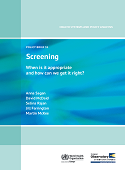Screening. When is it appropriate and how can we get it right? (2020)

Download
Technological and other scientific advances have made it possible to screen for ever larger numbers of molecules and see inside the human body with a level of detail that was once unimaginable. Where there is good evidence that detecting a condition early will, overall, be beneficial for those who are screened, then it may be appropriate to design and implement a formal screening programme. However, just because something can be done does not mean that it should be done as screening may bring benefits as well as harm.
In this brief the authors start by explaining the core components of a screening programme, highlighting that, while seemingly simple, putting together all elements of a screening programme is very complex. They then ask when screening should be done, emphasizing the continued relevance of Wilson & Jungner’s screening principles. In addition, they examine the pressures to implement screening and, where screening is inappropriate, suggest ways to reduce it. When screening is appropriate, evidence is presented on how to achieve optimal results. This brief is an essential reading for anybody involved in the decisions on screening or its provision.
This publication was produced as a collaboration between the European Observatory on Health Systems and Policies and the WHO Regional Office for Europe. This work was done in support of the WHO European Conference on Screening (Copenhagen, 11-12 February 2020) and the wider WHO European initiative aiming to improve screening practice through the life-course and thereby to increase effectiveness, maximize benefits and minimize harm.
The brief’s key messages are:
- Screening may bring benefits but also harm; just because it can be done does not mean that it should be done – and the same resources may be better used in other ways.
- Population screening should be done within an organized screening programme that includes certain core elements, from identifying target populations, through treatment, to monitoring and evaluation. There is no justification for unorganized screening. While it may seem simple, putting together a screening programme is a complex task and requires many things to work both inside and beyond the health system.
- Wilson & Jungner’s screening principles remain the gold standard when deciding on implementing, continuing or discontinuing screening programmes, although they often require expert judgement as well as high quality evidence, including consideration of resource implications, effectiveness and cost effectiveness, as well as adaptation to country context.
- Care is needed when deciding to implement a screening programme to protect against the potential for commercially driven vested interests and supplier-induced patient demand. It is essential that decisions to implement, continue, or discontinue screening programmes are made transparently, setting out clearly the arguments for and against.
- It is also important to identify barriers to maximizing the effectiveness of programmes and put in place measures to overcome them. Potential barriers may relate to health system structures, such as payment models and availability of human, physical and financial resources. Potential solutions include financing models that encourage appropriate use, improving information flows, ensuring health workers have appropriate skills, and removing logistical barriers.



